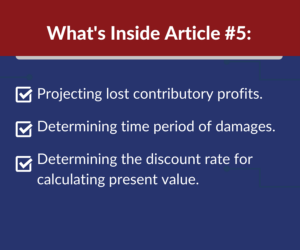
Article 5: Determining Damages—Lost Contributory Profits
Welcome back to our series on working with a financial expert in business litigation. If you missed the last article that explored how an expert determines which primary approach to apply, you can read it here. This time, we’re looking more closely at one of the two primary damages approaches—determining lost contributory profits and how a damages expert applies this approach.
Calculating Lost Contributory Profits
Lost contributory profits analysis is applicable when a business has been damaged or a business segment has been destroyed but the business itself continues. The idea behind this approach is that a damages award for lost contributory profits should return to the business the profits it lost because of the alleged damaging act. These profits would otherwise have been available to the business to contribute to covering the business’s expenses.
In determining the lost contributory profits the expert identifies and calculates the following:

- The lost revenue stream associated with a particular contract, product, or customer.
- The expenses that would have been incurred in earning the lost revenue but are “saved” because the revenue dollar was not earned. For example, with a manufacturing business, these include the raw material and direct labor needed to manufacture a product to be sold. For a service business, there may not be raw material expense, but there would be direct labor and other expenses, typically reported as operating expenses that are related to the lost revenue stream.
- Other operating expenses associated with the lost revenues, such as sales commissions.
After determining a business’s revenue and expense structure, there are a number of methods that can be used to determine the total dollar amount of the lost contributory profits.
- 1. The total amount of lost profits may be based on the business’s actual performance – frequently referred to as a “before and after” analysis. This is appropriate if the damaging event has ended or been fully mitigated. If the damage is continuing, then projections of continuing damage may be needed.
- 2. For some businesses, particularly new businesses without much history of operations, a comparison to other businesses may be necessary – frequently referred to as the “yardstick” approach. This estimates what should have happened absent the damaging event. The strength of this approach depends on the degree of comparability among the businesses to which the damaged business is compared.
- 3. If the damages are continuing, projections of future lost contributory profits need to be developed. This requires estimates of future revenues and expenses which may change over time, as well as an estimate of the period over which the contributory profits are lost to the business.
Businesses are dynamic. The expert needs to confirm that other factors do not exist that are, or could be, causing the change in revenues. Factors outside of the business, such as new competition, changing technology, or product obsolescence are a few that can affect business growth and profits causing a decline irrespective of the alleged damaging act.
Determining the Time Period of Damages
As noted above, if the damages have not ended and the business is continuing but with lesser profitability due to the alleged damaging action, the projection of lost profits must be developed by the expert. Ultimately the expert needs to choose a reasonable time period to continue the projections of damages and provide the logic supporting this assumption. There are any number of ways to approach this portion of the analysis but it is always dependent upon the facts and circumstances of the case and the subject business.
Regardless of the cause of the action, a “but for” analysis is usually necessary. In other words, what would have happened “but for” the actions of the defendant? How long would the plaintiff and defendant have maintained a business relationship? What is the history of the relationship between the plaintiff and the defendant and how likely is it that the relationship would have continued, but for the damaging act? Or, in the case of a breach of contract, what were the terms of the contract?
Determining the Discount Rate for Calculating Present Value of Damages
If the damages continue into the future, an estimate of these continuing damages is calculated as described above and the damages expert must then determine the present value of these projected lost profits by determining a discount rate. The size of this discount rate will have considerable impact on the present value amount of any estimated continuing damages. While the discount rate applied in a damages analysis is similar to the discount rate applied in a discounted cash flow valuation of an entire business, it will be different.
The discount rate applied in a discounted cash flow valuation of an entire business reflects the risks to an investment in the entire business from providers of debt and equity capital to the business (called the weighted average cost of capital). Lost profits projected for damages purposes, however, typically are not the cash flows of the entire business; they reflect lost profits from one segment of the business and they usually do not reflect the business’s other operating expenses or ‘overhead’. When one considers the ”place” of the lost contribution margin on the company’s financial statements it is before the business’s fixed expenses and before the returns available to providers of capital. Therefore, the discount rate applied to the projected lost contributory profits would be expected to be less than the business’s overall weighted average cost of capital.
The most important principle is that the damages expert needs to present an objective basis for every element of the discount rate proposed. Ultimately, the discount rate used should account for the time value of money and reflect the risks associated with the specific stream of contributory profits or other lost cash flows that have been projected.
Conclusion
Each case is unique and it is the expert’s job to gather the facts, analyze history and develop reasonable assumptions when determining lost contributory profits.
Litigation attorneys engage damages experts or business appraisers for a number of different litigious reasons. The financial expert decides which of two primary approaches to apply given the particular circumstances. Providing the expert the time and flexibility to obtain necessary documents, sometimes atypical documents and/or reports, is important to considering alternative analyses and conclusions.
Coming up Next Time
Next time, we will do a deeper dive into the other of the two primary approaches used by damages experts—determining lost business value.
We’re Here to Help
Hiring the right financial expert can have a significant impact on your case. Based on our firm’s 45+ years of experience focused entirely on determining damages and valuing businesses, we can provide insight, experiences, and ideas for ways to approach the financial portion of your litigation project that you may not have encountered yet.
Stay tuned to your inbox and follow Capital Valuation Group on LinkedIn as we share more from this series on successfully navigating working with financial experts through each phase of the litigation process. If you have a particular situation you would like to discuss, give us a call. We are happy to have a complimentary initial discussion.
Would you or other people in your firm find value in this series? Please share or they can subscribe to our email list here.

Cathy Durham is a principal of Capital Valuation Group, Inc., headquartered in Madison, WI. Capital Valuation Group has been helping business owners across the country understand, increase and unlock the value of their businesses for over 45 years through keynote speaking, valuation analysis, determining damages and providing expert witness testimony. Cathy welcomes conference and event speaking inquiries and can be reached at cdurham@capvalgroup.com. Phone 608-257-2757
